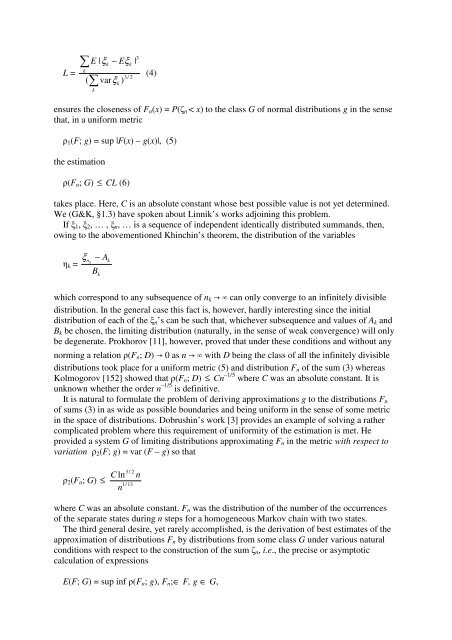7. Probability and Statistics Soviet Essays - Sheynin, Oscar
7. Probability and Statistics Soviet Essays - Sheynin, Oscar
7. Probability and Statistics Soviet Essays - Sheynin, Oscar
You also want an ePaper? Increase the reach of your titles
YUMPU automatically turns print PDFs into web optimized ePapers that Google loves.
L = Ek( k| ξ − Eξ|kvarξ)kk3/ 23(4)ensures the closeness of F n (x) = P( n < x) to the class G of normal distributions g in the sensethat, in a uniform metric 1 (F; g) = sup |F(x) – g(x)|, (5)the estimation(F n ; G) ≤ CL (6)takes place. Here, C is an absolute constant whose best possible value is not yet determined.We (G&K, §1.3) have spoken about Linnik’s works adjoining this problem.If 1 , 2 , … , n , … is a sequence of independent identically distributed summ<strong>and</strong>s, then,owing to the abovementioned Khinchin’s theorem, the distribution of the variables k =ξnk− ABkkwhich correspond to any subsequence of n k can only converge to an infinitely divisibledistribution. In the general case this fact is, however, hardly interesting since the initialdistribution of each of the n ’s can be such that, whichever subsequence <strong>and</strong> values of A k <strong>and</strong>B k be chosen, the limiting distribution (naturally, in the sense of weak convergence) will onlybe degenerate. Prokhorov [11], however, proved that under these conditions <strong>and</strong> without anynorming a relation (F n ; D) 0 as n with D being the class of all the infinitely divisibledistributions took place for a uniform metric (5) <strong>and</strong> distribution F n of the sum (3) whereasKolmogorov [152] showed that (F n ; D) ≤ Cn –1/5 where C was an absolute constant. It isunknown whether the order n –1/5 is definitive.It is natural to formulate the problem of deriving approximations g to the distributions F nof sums (3) in as wide as possible boundaries <strong>and</strong> being uniform in the sense of some metricin the space of distributions. Dobrushin’s work [3] provides an example of solving a rathercomplicated problem where this requirement of uniformity of the estimation is met. Heprovided a system G of limiting distributions approximating F n in the metric with respect tovariation 2 (F; g) = var (F – g) so that3 / 2C ln n 2 (F n ; G) ≤1/ 13nwhere C was an absolute constant. F n was the distribution of the number of the occurrencesof the separate states during n steps for a homogeneous Markov chain with two states.The third general desire, yet rarely accomplished, is the derivation of best estimates of theapproximation of distributions F n by distributions from some class G under various naturalconditions with respect to the construction of the sum n , i.e., the precise or asymptoticcalculation of expressionsE(F; G) = sup inf (F n ; g), F n ;∈ F, g ∈ G,









